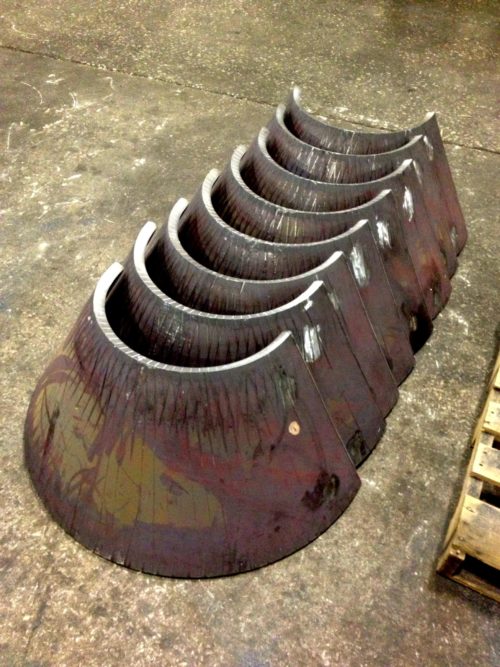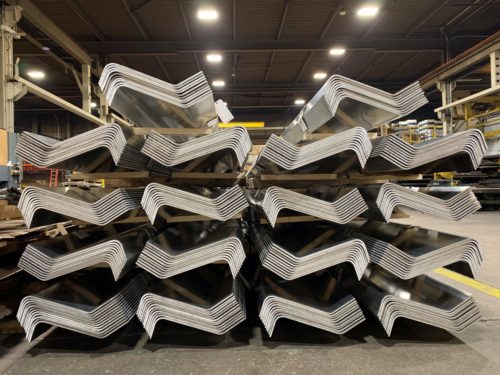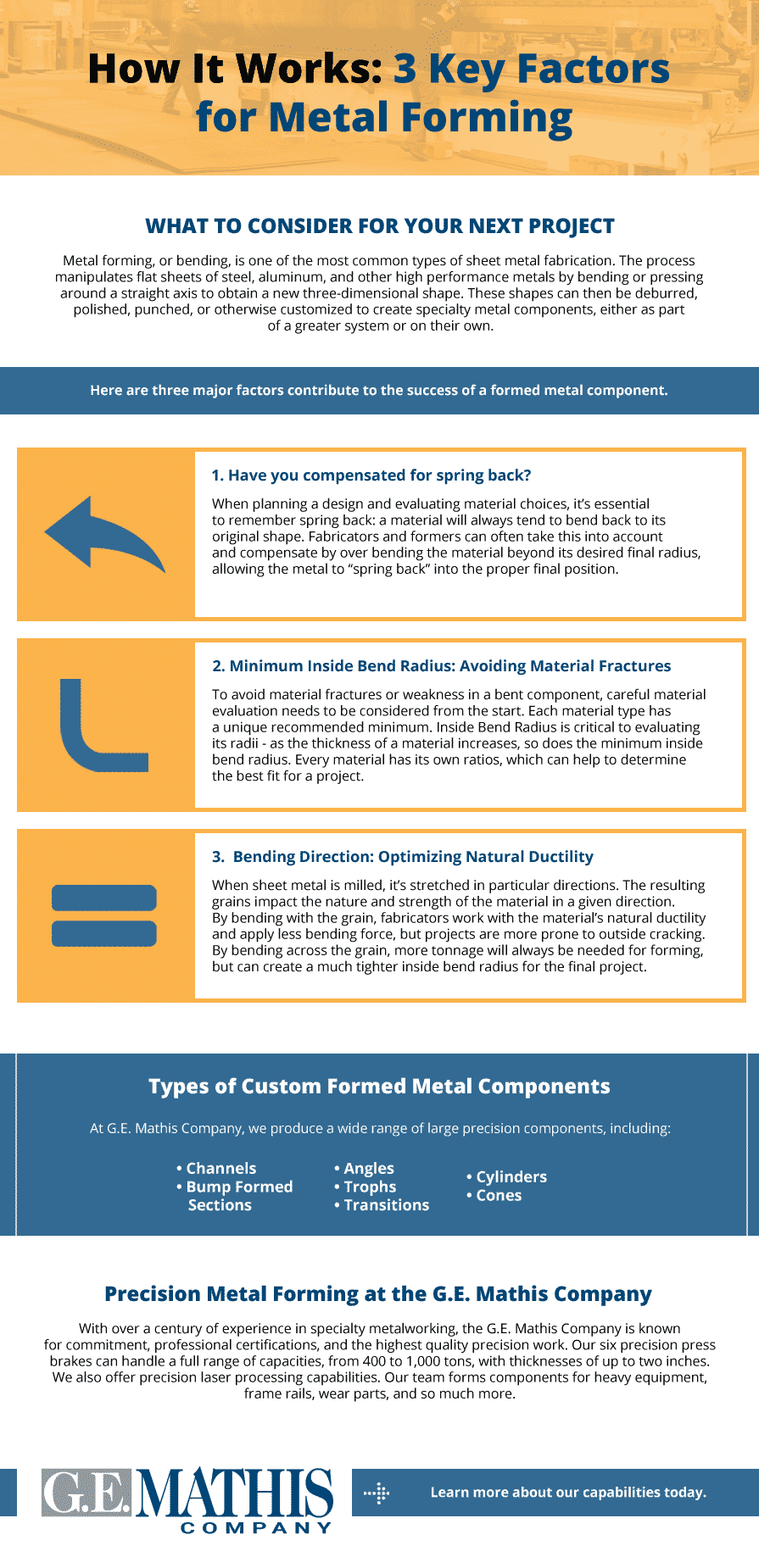All About Metal Fabrication
Metal fabrication refers to the process of cutting, shaping, or molding raw or semi-raw metal materials into an end product. Depending upon the type and grade of metal, as well as the desired end product, metal fabricators may employ a variety of techniques to manufacture cost-effective, high-quality components for a wide range of industrial applications.
Types of Metal Fabrication Processes
Some of the different metalworking methods metal fabricators employ include:
Cutting
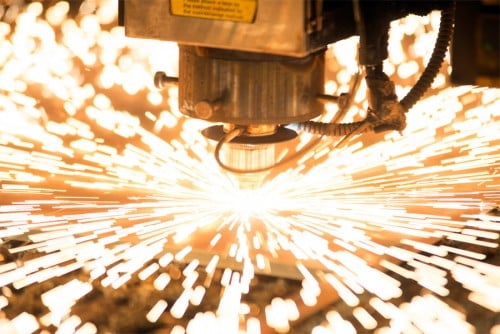
- Sawing is the oldest method of producing straight cuts through metal materials.
- Laser cutting employs a high-powered, focused laser beam of light to cut through the metal materials.
- Waterjet cutting operations utilize a high-powered water stream to cut through different materials, including metal.
- Plasma Cutting uses a mixture of swirling gases to cut through metal.
- Shearing uses two large blades to cut through metal like a giant pair of scissors.
- CNC cutting uses a computer-controlled machine to make precise cuts through metal via a variety of metal cutting techniques (e.g., laser cutting, plasma cutting, etc.)
- Die cutting employs steel rule (flatbed die cutting) or cylindrical (rotary die cutting) dies to cut out precise metal shapes.
Forming/Bending
Unlike cutting, forming (or bending) doesn’t remove material from the metal work-piece. Instead, the process alters the work-piece with a machine such as a press brake, or by a hand-held method such as with a hammer, or die to fit the required specifications.
Welding
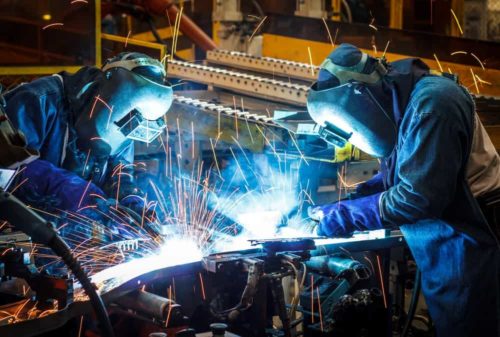
- Submerged arc welding (SAW): This welding method employs a continuous electrode to create an arc between the welding rod and the work-piece. The addition of a thick granular flux forms a shield that protects the weld zone from atmospheric contamination during operations.
- Shielded metal arc welding (SMAW): This welding method—also referred to as stick welding—uses a welding rod coated in flux that carriers a high-power electrical current. The coating breaks down during welding operations, forming a layer of slag and a gas shield that protects the weld as it cools.
- Gas metal arc welding (GMAW): This welding method—also known as MIG welding—relies on an adjustable and continuous solid wire electrode. During operations, the electric arc formed between the work-piece and the electrode heats and melts the base metals to form the weld.
- Gas tungsten arc welding (GTAW): This welding method—also called TIG welding—requires the use of a non-consumable tungsten electrode. It produces strong welds without fillers.
- Fluxed core arc welding (FCAW): This welding method is similar to GMAW welding, except it utilizes a tubular wire electrode filled with flux rather than a solid wire electrode. Self-shielded FCAW operations rely only on flux to protect the weld zone, while dual-shielded FCAW operations rely on both flux and an external shielding gas.
Stamping
Uses a top and bottom die molded into a custom 3-dimensional shape. When the metal is pressed between the two dies, it conforms to the desired shape. This process is used to make many complex metal shapes, such as body panels for the automotive industry.
Machining
Uses CNC-controlled machinery with various cutting tools to rapidly produce a custom 3-dimensional metal component by removing unwanted materials.
Advantages and Applications of Metal Fabrication Processes
There are several different types of metal fabrication processes employed by industry professionals to produce metal parts and products. As each process utilizes different techniques and equipment, it offers distinct advantages and best use cases.
Advantages and Applications of Cutting
Perhaps the most ubiquitous of all metal fabrication processes, cutting can be employed alongside other methods. In general, cutting offers several advantages with more modern techniques providing enhanced manufacturing capabilities. Some of the advantages of using cutting to fabricate metal parts include:
- Greater precision
- Higher repeatability
- Faster production speeds
- Better cost-effectiveness
Advantages and Applications of Forming/Bending
Metal fabricators use forming operations—e.g., rolling, indenting, and bending—to produce many metal parts, such as pipes, enclosures, and boxes. The advantages of using these operations include:
- Broader product capabilities
- Greater part design flexibility, including for complex shapes and geometries
Advantages and Applications of Welding
In general, welding allows for minimal waste production, reduced labor and material costs, and process portability. Each of the individual welding techniques also offers unique benefits. For example:
TIG Welding Benefits
Commonly used for aluminum and aluminum alloys, TIG welding produces a better surface finish than MIG welding and doesn’t require a filler material to produce the weld.
MIG Welding Benefits
Commonly used on steel, MIG welding does require the use of consumable filler material (i.e., the feeding wire). However, compared to TIG welding, it is faster and easier to control.
Sticking Welding Benefits
Commonly used on iron and steel, stick welding is the simplest welding technique. As such, it is used extensively for industrial fabrication applications.
Advantages and Applications of Stamping
Stamped parts are found across a diverse set of industries. The stamping process allows for:
- Higher precision and accuracy
- Faster production speeds
- Lower per-unit production costs (for high-volume runs)
Advantages and Applications of Machining
Machining is a broad industrial term for subtractive manufacturing processes, such as drilling, milling, and turning. While some companies still rely on manual machining units, many companies have adopted the use of computer numerical control (CNC) machining equipment. The latter enables industry professionals to achieve the following:
- Tighter tolerances
- Higher production consistency
- Greater cost-efficiency (for small to medium runs)
Metal Fabrication Solutions From G.E. Mathis Company
At G.E. Mathis Company, we offer industry-leading metal fabrication services to customers across a diverse set of industries. Equipped with a 135,000 square foot, state-of-the-art manufacturing facility and over a century of industry experience, our team provides:
Precision Laser Processing
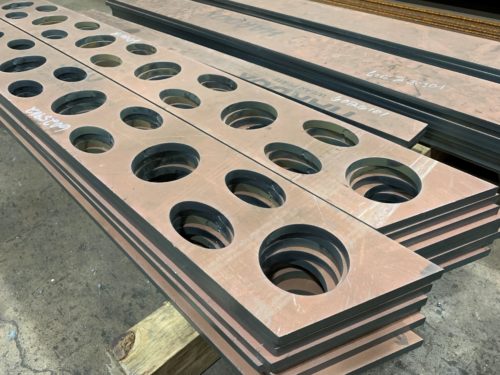
Precision CNC Plasma Cutting
We utilize 4-axis machines capable of high-definition cutting action to provide precision CNC plasma cutting services. The equipment’s 400 amp, straight, dual-head, and contour beveling capabilities help us provide superior results across a wide variety of materials, including carbon, aluminum, stainless steel, and exotic metals.
Precision Forming/Bending
For our precision forming/bending operations, our team utilizes eight hydraulic press brakes, including two equipped with CNC capabilities. These machines feature 400- to 1,000-ton capacities and accommodate thicknesses up to 2 inches and lengths of 20, 20, 30, 23, 25, 40, and 48 feet.
Some of the formed/bent components we fabricate include:
- Cones
- Cylinders
- Ob-rounds
- Segments
- Channels and angles
- Bump formed sections
We process a variety of materials in these operations, such as:
- Carbon steel
- Stainless steel
- Aluminum
- Brass
- Bronze
- Copper
- Titanium
- Hardox® wear plate
Precision Welding
Our AWS-certified welders are capable of providing precision arc and MIG welding services using CNC-controlled welding and fully automated processes, including:
- Dual-wire submerged arc welding
- Flux cored arc welding—i.e., FCAW
- Gas metal arc welding—i.e., GMAW
- Gas tungsten arc welding—i.e., GTAW
- Shielded metal arc welding—i.e., SMAW
- Submerged arc welding—i.e., SAW
We weld materials up to 12 feet wide and 50 feet long, including:
- Carbon steel
- Stainless steel
- Aluminum
- Hardox® wear plate
HARDOX® Wearparts Fabrication
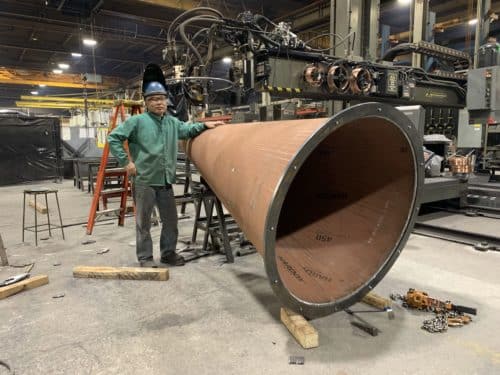
- HARDOX 450
- HARDOX 500
- STRENX 100 (Domex® 100)
- STRENX 110 (Domex® 110)
- STRENX 700
- WELDOX 100
- WELDOX 110
These products are available in up to 2-inch thicknesses with industry-leading tolerances to meet even the most demanding application requirements.
In addition to being an ISO 9001:2015-certified manufacturer, G.E. Mathis Company can provide the following services:
- PPAP (Production Part Approval Process) – All Levels
- FAIR (First Article Inspection Report)
- Capability Studies (Statistical Process Control)
- CMRT (Conflict Minerals Reporting Template)
At G.E. Mathis Company, we have over a century of experience providing metal fabrication solutions. If you have a metal fabrication project, we can meet your needs. Contact us today for more information about our metal fabrication capabilities or request a quote from one of our experts for your next project.
How to Source a Metal Forming Company
Partnering with a metal forming company increases a manufacturer’s ability to fill orders quickly. Highly proficient metal forming and bending processes require expert technicians and advanced machinery. These elements allow metal forming companies to produce high-quality components that fit the specifications and expectations of their customers.
A metal forming company is defined by multiple factors, such as:
- Capabilities. A prospective partner should have the equipment and skill to complete a broad range of projects, including those with complex geometries and tight tolerances.
- Experience. Precision forming requires extensive practical experience to achieve optimal results.
- Quality. High standards ensure that every component meets or exceeds expectations. A reputable metal forming company earns third-party validation via certifications and positive reviews.
- Methodology. Complex projects require a higher level of organization. An experienced metal forming partner can keep track of multistage projects easily and accurately and successfully perform a wide range of processes.
- Customer service. In the end, the goal of precision forming is to produce high quality components that contribute to the customer’s success. Good communication and a commitment to integrity ensure the best results.
If any of these elements are out of place, the customer experience and quality of the end product will suffer as a result.
Assessing the Quality of Precision Forming Companies
Dimensions are the key to creating ideal metal formed components. With the right equipment, a precision metal fabricator can control the quality of their finished items and adhere to the highest industry standards.This includes the ability to:
- Accommodate metals of varying type, grade, and thickness.
- Choose a bend sequence based on desired tolerance.
- Adhere to minimum recommended bend radii for materials.
- Bend metals to accommodate desired grain direction.
- Use a variety of tooling to facilitate production of precision formed components.
When evaluating a prospective metal fabricator, look for these team members to ensure you will receive the highest quality service throughout the fabrication and delivery processes.
- Estimators who break down the costs of complex projects in a thorough, yet easy to understand manner.
- Engineers with experience converting plans and drawings into feasible projects.
- Certified craftsmen on the shop floor who can apply their training and experience in their respective fields.
- Experienced project managers who can effectively communicate with all stakeholders to ensure efficiency at every step of the project.
Common Errors in the Metal Fabrication Process
Metal fabrication processes often require intricate adjustments and careful attention to detail. When processes and calibrations are not closely monitored, these common errors can occur.
- Not having enough tonnage to form the desired thickness and length.
- Cracks or fractures in the material can occur when a material has been formed with incorrect size tooling. Splitting occurs when a material has been stretched beyond its limits.
- Springback that interferes with the bending and shaping process. Unexpected shape changes can make it impossible to achieve the correct final form.
- Incorrect flat development of blanks, making it impossible to achieve desired shape of part within tolerance.
These errors can compromise an entire supply of fabricated components. Catching these problems early in the process gives engineers the ability to adjust their processes and realize better results. Your metal forming partner should have a stringent quality assurance process in place to identify and resolve these problems.
Industrial Metal Fabrications from G.E. Mathis Company
Research your options before choosing a partner for your metal forming project. Check their capabilities, staff certifications, and previous experience to ensure they have the ability to complete your job within the time, budget, and specifications necessary. It’s also important to understand a company’s technical limitations before choosing to partner with them for your manufacturing project.
G.E. Mathis Company provides precision metal forming services for a variety of industrial applications. Our metal fabrication processes include CNC plasma cutting, laser cutting, plate rolling, welding, shearing, metal forming and bending, and more.
In addition to being an ISO 9001:2015-certified manufacturer, G.E. Mathis Company can provide the following services:
- PPAP (Production Part Approval Process) – All Levels
- FAIR (First Article Inspection Report)
- Capability Studies (Statistical Process Control)
- CMRT (Conflict Minerals Reporting Template)
Please contact our representatives directly or request a quote for a personalized assessment of your project.
4 Tips for Designing Large, Cost-Effective Components
Large parts are often challenging to fabricate; making cost-effective decisions during the design stage can help to ensure manufacturing success. Sometimes a small change in a design can reduce a project’s cost substantially.
1. Make Things Easy

Easy-to-read drawings take the guesswork out of fabricating. As this is often the only thing that the shop has to work with, it is important to make sure your information is clear, so your manufacturer understands all of the details of the part they are creating.
2. Provide Context
Clearly communicate how you plan to use the final product. Experienced metalworkers will be better equipped to take on your large component fabrication project if they understand the part’s intended use.
All technical drawings and documents should include these details and provide vital information to manufacturers and help them to choose the best equipment for cost-effective fabrication.
3. Be Consistent
Legibility is important, but drawings and prints must also provide consistent and clear information. In-depth data is more important than exact scale drawings and will ensure the best accuracy.
Every drawing should convey the dimensions and tolerances of the product, with clear labeling that identifies all required materials and finishes.
4. Be Conscientious
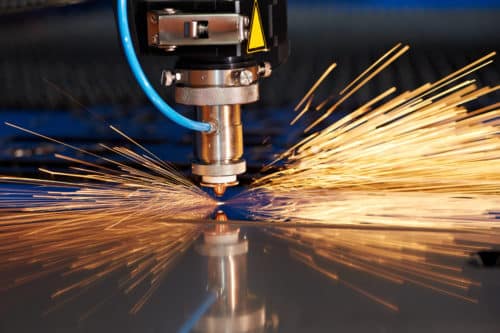
If you’re not sure what processes will be used, like laser cutting, we’ll be happy to talk to you about it. We will gladly work with you towards a solution.
Your Partner in Large Scale Manufacturing
By following these guidelines, your designs will be easily fulfilled to suit all of your application’s requirements. At G.E. Mathis Company, we do our part by maintaining the tooling, equipment, and expertise to complete precision welding fabrication projects of virtually any size.

In addition to being an ISO 9001:2015-certified manufacturer, G.E. Mathis Company can provide the following services:
- PPAP (Production Part Approval Process) – All Levels
- FAIR (First Article Inspection Report)
- Capability Studies (Statistical Process Control)
- CMRT (Conflict Minerals Reporting Template)
For further information, contact us today or request a quote for your next project.
How It Works: 3 Key Factors for Metal Forming
What to Consider for Your Next Project
Metal forming, or bending, is one of the most common types of metal fabrication. The process manipulates flat sheets of steel, aluminum, and other high performance metals by bending or pressing around a straight axis to obtain a new three-dimensional shape. These shapes can then be deburred, polished, or otherwise customized to create specialty metal components, either as part of a greater system or on their own.
Here are three major factors contribute to the success of a formed metal component.
1. Have you compensated for spring back?
When planning a design and evaluating material choices, it’s essential to remember spring back: a material will always tend to bend back to its original shape. Fabricators can often take this into account and compensate by over bending the material beyond its desired final radius, allowing the metal to “spring back” into the proper final position.
2. Minimum Inside Bend Radius: Avoiding Material Fractures
To avoid material fractures or weakness in a bent component, careful material evaluation needs to be considered from the start. Each material type has a unique recommended minimum. Inside Bend Radius is critical to evaluating its radii — as the thickness of a material increases, so does the minimum inside bend radius. Every material has its own ratios, which can help to determine the best fit for a project.
3. Bending Direction: Optimizing Natural Ductility
When sheet metal is milled, it’s stretched in particular directions. The resulting grains impact the nature and strength of the material in a given direction, so be sure to note whether a sheet is being formed with (longitudinally) or across the grain.
By bending with the grain, fabricators work with the material’s natural ductility and apply less bending force, but projects are more prone to outside cracking. By bending across the grain, more tonnage will always be needed for forming, but can create a much tighter inside bend radius for the final project.
Types of Custom Formed Metal Components
Metal forming specialists craft the critical components needed to support almost every industry — aerospace, military, automotive, medical, food service, manufacturing, communications — the list goes on and on. At G.E. Mathis Company, we produce a wide range of large precision components, including:
- Channels
- Angles
- Formed Pan sections
- Transition segments
- Bump Formed Sections
- Cones
Precision Metal Forming at the G.E. Mathis Company
With over a century of experience in specialty metalworking, the G.E. Mathis Company is known for commitment, professional certifications, and the highest quality precision work. Our eight precision press brakes can handle a full range of capacities, from 400 to 1,000 tons, with thicknesses of up to two inches. We offer metal fabrication beyond bending and forming, too — precision laser processing, plasma cutting, and welding are a few of our capabilities.
Our team forms components for heavy equipment, frame rails, wear parts, and so much more. Contact us to discuss your next project with one of our metal forming professionals or learn more about our capabilities today.
Our Metal Forming Skills are a Work of Art
Throughout the manufacturing industry, there has been a lot of discussion around what is known as the “skills gap.” The skills gap –essentially the lack of workers with appropriate skills for the industry—is becoming more of a problem as the baby boomer generation is beginning to retire and the younger workforce are finding careers in other fields. Not only is the skills gap affecting the bottom line, but’s it’s also providing manufacturers with a major challenge.[1]
Here at G.E. Mathis Company, we understand the importance of these technical skills, as they allow our craftsmen to perform at the highest levels. Take, for example, our forming capabilities. Our advanced equipment and expertise allow us to process metal in a variety of dimensions and shapes, even up to 2” thick. Taking our forming services to the next level, we can bend long parts up to 48 ft. long.
Forming metal is an art, a skill acquired through observation and instruction. It is a skill that needs the human touch, one that cannot be completed by a robot or machine. Our skilled craftsmen pride themselves on their ability to form almost any shape. Some of the special shapes that we form, such as cone segments, cannot be processed through automation; instead, the operator needs to form the radiuses in the component using our unique equipment, working the metal blank to form the shape to the customer’s specifications. There is a complex process that we go through to form these complex parts.
This process requires a lot of technical skill, something that is becoming more and more unique, as we have seen due to the skills gap. However, our shop team continues to put this high level of skill into each part that they make, no matter what the customer’s specifications are. In fact, two recent projects we worked on exemplify the type of skill needed for metal forming: eccentric cones and elbow transitions.
Eccentric Cones
Unlike more traditional concentric cones, where the center points of each end of the cone are the same, the eccentric cones have these center points offset.
Elbow Transitions
Elbow transitions are used where a pipe needs to make a turn in an assembly. These also require a very specific and high level of skill to be able to fabricate and fit together with precision.
Neither of these projects had straight-forward dimensions, nor could they simply be made by an automated machine. Instead, they required specific radiuses that needed to be formed by a skillful hand. Rising to the challenge, our craftsmen have the skills to do so. G.E. Mathis Company will assure that these skills never become a lost art.
[1] http://www.sandiegonewsroom.com/business-finance/1282-how-to-combat-the-manufacturing-skills-gap






